Meet Vortex, Inc. Homebrewed in Lagos, Nigeria, this creative content and entertainment company is changing the face of African comic production. Through Vortex, African culture finds unique expression predominantly through the iconic visual language of the comic book. Galvanising the continent by exporting African stories made by African creators to a broader audience, Vortex publishes stories that are abundantly spiced with the distinct flavour of the Motherland.
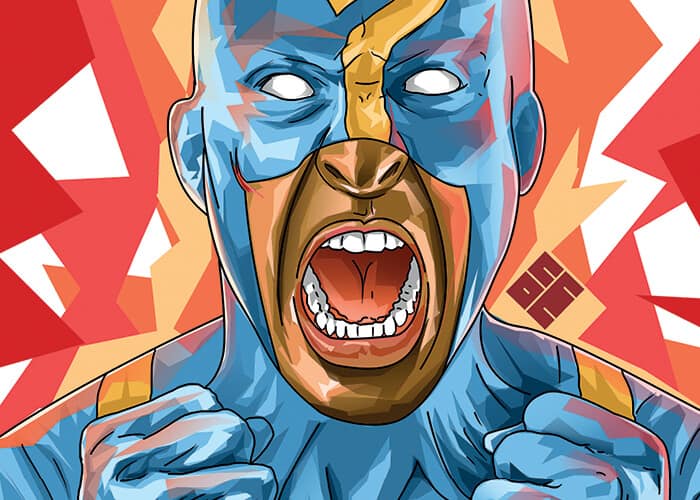 Detail of Strike Guard, art by Ayodeji Afolabi. All rights reserved to Vortex, Inc. All images courtesy of Vortex, Inc.
Detail of Strike Guard, art by Ayodeji Afolabi. All rights reserved to Vortex, Inc. All images courtesy of Vortex, Inc.
Su Opperman: What drove you and your team to create Vortex, Inc.?
Somto Ajuluchukwu: Vortex, Inc. was born from a love of telling stories – African stories – and sharing our culture. Those are the two major pillars that hold the ideology that the company is built and centered on. Vortex is a culture, so it was more like a magnetic movement of like-minded people who are passionate about these two things and slowly it has distilled to what it is now.
Vortex is also not your average comic company. We have a radical edge to us and are huge on social commentary. We see our comics as not just a platform to tell stories but also to address issues which are not only unique to our environment but globally relevant as well. For example, Sannkofamaan addresses the origin of the situation in the Niger Delta (Nigeria), Strike Guard addresses issues such as cultism in higher institutions and June XII tackles corruption in government. We do this to pass on valuable messages to our young readers and at the same time raise heroes who tackle real life evils personified in comic book villains.
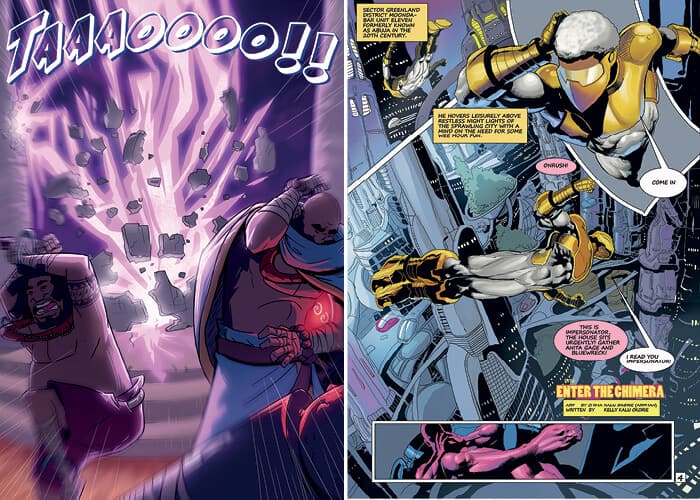 LEFT TO RIGHT: Page from Mumu Juju , 2015/2016. Art and colors by Etubi Onucheyo; Page from Wrath House , art and colors by Chima Kalu. All rights reserved to Vortex, Inc. Image courtesy of Vortex, Inc.
LEFT TO RIGHT: Page from Mumu Juju , 2015/2016. Art and colors by Etubi Onucheyo; Page from Wrath House , art and colors by Chima Kalu. All rights reserved to Vortex, Inc. Image courtesy of Vortex, Inc.
Do you feel that Vortex, Inc. has changed the Nigerian comic scene?
I wouldn’t really call it changing. I’ll say we have contributed immensely to the entire body of work which is the industry. We began by doing things differently and daring to bring our characters to life in more ways than the comic books. We used our Mumu Juju lead characters for animated educational content about states and capitals, which was presented at the Learn Africa Conference for Longman Nigeria Plc. Since our arrival on the comic scene we have thickened the competition and now everyone brings their ‘A-game’ on quality, consistency and business engagement because they have seen how aggressive we are and how we’ve thrived – based on pure initiative – in our partnerships and sponsorships. I’d like to say that our appearance on the scene inspired a key turning point in the transition of the industry.
We’re never too scared to be as intellectual and direct on issues as we want to be. This fearless approach with our content has given us a diverse edge, which we’ve noticed that a few co-industry players are beginning to emulate. Also, our wide network of creators has set an example for collaboration as a force of growth in the industry.
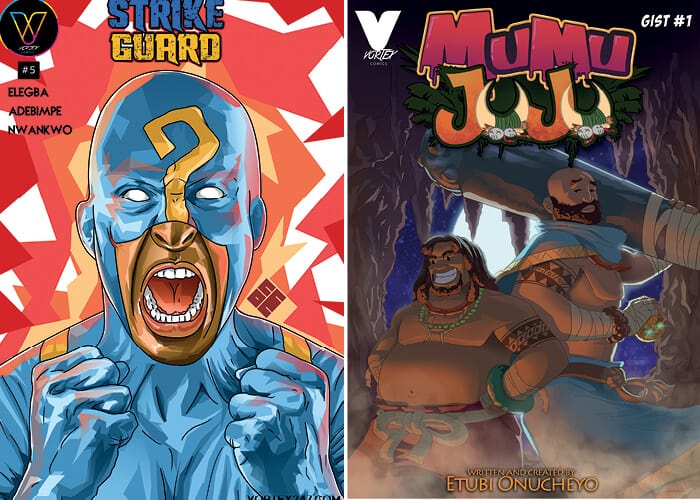 LEFT TO RIGHT: Page from Strike Guard, art by Ayodeji Afolabi; Page from Mumu Juju , all pictures by Etubi Onucheyo.
LEFT TO RIGHT: Page from Strike Guard, art by Ayodeji Afolabi; Page from Mumu Juju , all pictures by Etubi Onucheyo.
What are the greatest hurdles in gaining an audience for Vortex?
We’ve successfully overcome a number of hurdles, such as consistency, relatability and quality, and in building our readerbase and following. I believe a primary challenge now is drawing our local readers’ attention from foreign products. We want people to obsess about our universe of characters like they do about publishing companies in America and Asia. Even though we are far smaller than those corporations, I feel that, in our little niche way, we deserve a larger core fanbase of African people. We tell their stories directly, tailoring our comics and universe to suit what we experience daily. We have already noticed consistency and growth in numbers over the past months so we believe people will wake up to the culture soon.
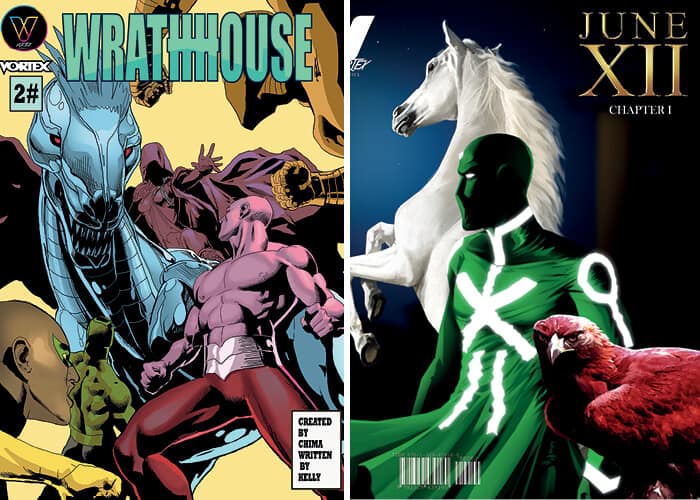 LEFT TO RIGHT:Page from Wrath House. Art by Chima Kalu; Page from June XII. Art by Ibrahim Ganiyu. All rights reserved to Vortex, Inc.
LEFT TO RIGHT:Page from Wrath House. Art by Chima Kalu; Page from June XII. Art by Ibrahim Ganiyu. All rights reserved to Vortex, Inc.
Is the high cost involved in printed media in Nigeria a setback for Vortex?
Prints are out now! The high cost of paper (because even that is imported) and power sustenance has made prints a headache for press companies that, in turn, transfer the headache to the publishers. Although we have finally received our first batch of collectable, editioned prints, it took much longer than it should have. These factors not only affect production, but have an adverse effect on sales; we are forced to sell comics at higher prices and it brings down demand. It’s especially problematic because one of our key target markets is most accessible via print comics.
The truth is, even if we were to purchase semi-industrial printers, the cost of materials like paper and ink make it an economic warzone. However, we have to thank our readers and supporters for sticking with us through our price hike and continuing to buy our comics – it means a lot to us.
Vortex encompasses a diversity of titles, from Strike Guard and Wrath House to June XII (to name but a few), showcasing African creativity through a well-established transmedia network. Which title do you feel encapsulates the values of what you’re doing to the fullest, and why?
I appreciate that you see our movement in this light. We like to envision Vortex as a platform to redefine the perception of Africa – media is a powerful tool in defining cultures and geo-politics. I don’t believe we have done a thorough job in this department yet, but if we work as a team and always focus on the future, we will thrive.
It’s difficult to say whether one title expresses all the elements in full. I don’t think any single title does, to be honest. Each has their own unique angle and is the best for that specific focus, which makes the Vortex universe a holistic one. One title cannot go without the other and it’s an intertwined web of amazing stories, each showcasing an element of our people that you might not have experienced before. It’s like each title is a piece of a much larger jigsaw puzzle.
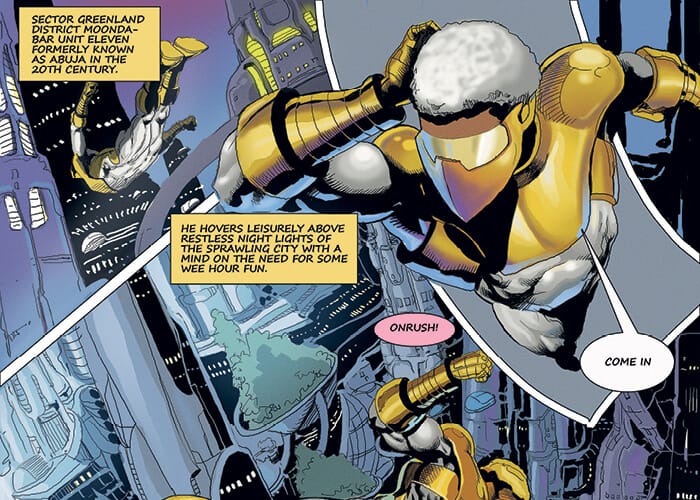 Detail of a page from Wrath House, art and colors by Chima Kalu.
Detail of a page from Wrath House, art and colors by Chima Kalu.
You once mentioned that your aim is for Vortex, Inc. to ‘become culture.’ In your position as creative director, how would you define a comics universe and what do you feel is its function within contemporary society?
If Vortex is going to be anything, it would not be what already exists. We are not the African version of Marvel, DC, Image or IDW, instead we are a fresh wave of illustrated content, or rather, illustrated knowledge. Just like how diverse Asian manga is, and how deep-rooted in the myths and culture of the Asian people it is, Vortex Comics not only serves to teach basic morals (like all comics do), but also educates readers about culture, myths, history and society or the social lifestyle of the African continent. There’s so much more and it stretches far further than calling our ancient deities out.
Su Opperman is the Head of the Comic Art unit for the Centre of Comics and Illustrative Book Arts, an NPO affiliated with the University of Stellenbosch. She is also co-editor of ComicArtAfrica.



